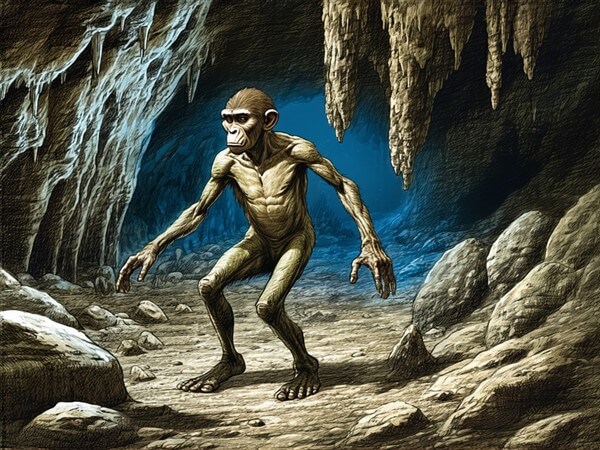Introduction
Human evolution has been shaped not only by our direct ancestors but also by our close relatives. Our understanding of the evolutionary history of Homo sapiens includes not only the direct ancestors of the Homo genus but also other Homo species that interacted genetically and culturally with these species. In this article, we will examine in detail species such as Homo neanderthalensis, Homo denisova, Homo floresiensis, Homo luzonensis, and Homo naledi, which are closely related to Homo sapiens but are not direct ancestors. Each of these species has contributed differently to the evolutionary development of Homo sapiens, enriching the history of humanity.
The study of these closely related Homo species allows us to understand how various branches and genetic mixtures emerged in human evolution. Additionally, the cultural and technological developments of these species provide important clues about the social structure and cognitive abilities of modern humans. In this article, we will examine the period in which each species lived, their physical and cognitive characteristics, and their evolutionary significance, thereby identifying their place in the evolutionary tree of Homo sapiens. This will help clarify the multi-layered nature of human evolution and the role of Homo sapiens in this process.
Homo Neanderthalensis (Neanderthal Humans)

Period of Existence
Homo neanderthalensis is an early Homo species that lived in parts of Europe and Asia approximately 400,000 to 40,000 years ago. This species coexisted with Homo sapiens and interacted genetically with modern humans. Neanderthals are known for their adaptation to cold climates and their ability to survive the harsh conditions of the Ice Age. Fossil remains have been found in Germany, France, Spain, and various regions of Asia, indicating that Neanderthals inhabited a wide and diverse geographical area. The existence of Neanderthals represents an important branch in the evolutionary tree of Homo sapiens.
Physical and Cognitive Characteristics
Homo neanderthalensis had a strong and robust physical build. Their muscular structure was adapted for intense physical activity. The average brain volume was similar to that of modern humans, but their brains had a different shape and structure. Their wide noses helped warm and humidify the airways in cold weather. Physically, thick bones, short legs, and an upright torso enabled them to retain heat more effectively in cold climates. Cognitively, Neanderthals demonstrated the ability to create complex tools, make fire, and build shelters. Their social structure allowed them to live in groups and cooperate with one another.
Evolutionary Significance
Neanderthals are genetically related to Homo sapiens, and genetic mixing between them and modern humans has been proven. This mixing contributed to the development of certain genetic traits and immune systems in modern humans. Neanderthals’ advanced toolmaking and hunting techniques served as examples for modern humans in the survival strategies of early human communities. Additionally, studying Neanderthals’ social and cultural structures demonstrates the importance of cooperation and communication in the development of human communities. The scientific study of Neanderthals helps us better understand the fragmented and dynamic nature of human evolution.
Homo Denisova (Denisovan Humans)

Period
Homo denisova is a species of Homo that emerged approximately 200,000 years ago and was discovered in the Denisova Cave in Siberia. This species serves as a genetic bridge between Homo sapiens and Neanderthals and is genetically closely related to both species. Although information about Denisovan fossils is limited, genetic analyses have provided important clues about their time period and geographical distribution. Denisovans are believed to have existed in various regions of Asia and may have coexisted with modern humans, leading to genetic mixing. Fossils of this species have been found not only in Siberia but also in Australia, Southeast Asia, and the Temple Caves.
Physical and Cognitive Characteristics
Homo denisova possesses many physical characteristics that have not yet been fully defined; however, DNA analyses indicate that this species has anatomical features distinct from modern humans and Neanderthals. It is speculated that Denisovans may have had thick bones and robust body structures to adapt to high altitudes. Brain volume may be similar to or slightly larger than that of Homo sapiens, which could indicate advanced cognitive abilities. Physically, Denisovans may have been slightly shorter than modern humans and may have had some differences in bone structure. Cognitively, it is estimated that Denisovans also possessed the ability to create complex tools and engage in social interactions.
Evolutionary Significance
Homo denisova has a genetic connection to Homo sapiens, and genetic mixing between the two has been proven. This genetic mixing has contributed to the genetic diversity of modern human populations, particularly in regions such as Australia and Southeast Asia. Denisovan DNA has had positive effects on the immune system in modern humans and contributed to certain adaptations. Additionally, the social structures and cultural practices of Denisovans provide important clues about the evolutionary development of modern human communities. Studying this species helps us better understand the complexity of human evolution and the interactions between different Homo species.
Homo Floresiensis (Flores Hobbit)

Period
Homo floresiensis was a humanoid species that lived on the island of Flores in Indonesia approximately 100,000 to 50,000 years ago. This species is notable for its small size and characteristics that differ from other human species. Fossils of Homo floresiensis have been found in areas such as the Loveman Cave, indicating that they evolved in isolation in this region. This isolated existence led to the development of unique physical characteristics in the Floresians. The limited resources and harsh environmental conditions of Flores Island highlighted the adaptive capabilities of Homo floresiensis and the advantages of their small size. The fossils of this species demonstrate the diversity of human evolution and the extent to which it can diverge during the adaptation process.
Physical and Cognitive Characteristics
Homo floresiensis was significantly smaller in size compared to other Homo species; adult individuals stood approximately 1 meter tall. This small body structure evolved as an evolutionary adaptation to the island’s resources and environmental conditions. While the brain volume was smaller than that of modern humans, this did not limit their cognitive abilities. Homo floresiensis had the ability to make advanced stone tools, which were used for gathering food and hunting. Physically, their small and delicate build enabled them to move quickly and maneuver effectively in confined spaces. Cognitively, the mysterious social structures and communication skills of Homo floresiensis demonstrate their ability to organize themselves into communities.
Evolutionary Significance
Homo floresiensis is an important species that shows how diverse human evolution can be. This species has helped us understand how unique evolutionary traits can develop as a result of isolation and environmental pressures. The small size of Homo floresiensis is seen as an adaptation to the scarcity of resources on the island. Additionally, this species’ ability to create advanced stone tools is an indication of cultural and technological developments that emerged independently during the evolutionary process. The study of Homo floresiensis has contributed to our understanding of how human evolution can progress in different ways across different regions and how human communities can adapt to environmental conditions. This species is a symbol of the diversity and adaptive capacity of humanity’s evolutionary past.
Homo Luzonensis

Period
Homo luzonensis is a Homo species discovered approximately 67,000 years ago on Luzon Island in the Philippines. This species is known from fossil remains discovered in 2019 and has revealed the extent of human evolutionary diversity. The fossils of Homo luzonensis were primarily found in the Callao Cave, indicating that they lived under harsh environmental conditions and developed unique adaptations. The isolated geography of Luzon Island led to the evolution of Homo luzonensis separately from other Homo species. The fossils of this species provide new insights into how humans can diversify in different ecosystems and geographical regions.
Physical and Cognitive Characteristics
Homo luzonensis is notable for its small size and a mix of modern and archaic features. The femur bones of this species are shorter and thinner than those of modern humans, indicating a smaller stature. Additionally, some hand and foot bones have a slender and elongated structure, supporting their adaptive traits. Physically, Homo luzonensis may have developed the ability to maneuver in confined spaces and use tools. Cognitively, this species’ tool-making and use suggest that they possessed complex thinking and problem-solving abilities. Although there is no definitive information about the brain volume of Homo luzonensis, tool use and likely social interactions point to advanced cognitive abilities.
Evolutionary Significance
Homo luzonensis represents a new branch in the evolutionary tree of humankind and demonstrates how complex human evolution can be. This species helps us understand how we could have diversified in an isolated geography and how the adaptive capabilities of the Homo genus could have been pushed beyond their limits. The study of Homo luzonensis provides important insights into the diversity of human evolution and how different species could have interacted with one another. Furthermore, the discovery of this species has allowed us to gain a deeper understanding of the evolutionary history of humans in Asia. Homo luzonensis highlights the dynamic and multi-layered nature of human evolution by offering new perspectives on evolutionary diversity and adaptation processes.
Homo Naledi

Period
Homo naledi is a species of Homo that lived approximately 335,000 to 236,000 years ago in the Yaeda and Rising Star caves in South Africa. This species gained significant attention in the scientific community following the discovery of its fossil remains in 2013. The fossils of Homo naledi were primarily found in the Inaka Cave and the Dinaledi Channel area of the Rising Star caves. These fossils indicate that Homo naledi occupies a unique position between modern Homo species and more ancient Homo ancestors. It is believed that Homo naledi lived in isolation for a long time and adapted to its environmental conditions. The fossil findings reveal that this species possesses both modern and ancient human evolutionary characteristics.
Physical and Cognitive Characteristics
Homo naledi exhibits physical characteristics unique to both modern humans and earlier Homo species. This species has a relatively small brain volume of approximately 465 cm³, significantly smaller than that of Homo sapiens. However, despite its size, Homo naledi provides strong clues about its cognitive abilities. Physically, Homo naledi’s thin bones, short legs, and narrow pelvic structure enabled it to move through narrow cave entrances. Additionally, Homo naledi’s hands exhibit features adapted for complex tool use, indicating that they were capable of making and using stone tools. Cognitively, the complexity of tool-making and potential symbolic communication demonstrated by Homo naledi point to advanced thinking abilities.
Evolutionary Significance
Homo naledi holds a unique place in human evolution because it combines both ancient and new evolutionary traits within the same individual. This suggests that Homo naledi encompasses different stages of the evolutionary process within the same species. Homo naledi’s tool-making and potential symbolic behaviors indicate that their social and cultural structures were more complex. Additionally, Homo naledi’s burial practices may indicate the early presence of complex ritual and belief systems. Studying this species helps us understand the extent of evolutionary diversity within the Homo genus and how different Homo species could coexist in the same geographical area. Homo naledi emphasizes the dynamic and multifaceted nature of human evolution and serves as an important link in the evolutionary journey of Homo sapiens.
Conclusion
Understanding other closely related Homo species provides a more comprehensive perspective on the evolutionary history of Homo sapiens. Species such as Homo neanderthalensis, Homo denisova, Homo floresiensis, Homo luzonensis, and Homo naledi have played important roles in the genetic, physical, and cultural development of modern humans. These species developed survival strategies in different geographical regions and environmental conditions, enhanced their adaptive capabilities, and contributed to various aspects of human evolution. Genetic mixing, advanced tool use, the complexification of social structures, and cultural practices are some of the critical contributions of these species to human evolution. During this process, it has become clear that Homo sapiens was significantly influenced not only by its direct ancestors but also by these close relatives.
The study of these species helps us better understand the complex and multi-layered nature of human evolution and provides deeper insights into how Homo sapiens reached its current form. Genetic research and fossil findings are shedding more light on the relationships and interactions between these species and offering new insights into humanity’s evolutionary past. Future research and technological advancements are expected to detail human evolution further and continue to shed light on the evolutionary past of Homo sapiens. This understanding is of vital importance for better comprehending the evolutionary processes that have shaped modern human identity.


 ByKus
ByKus Historia
Historia Logos
Logos Humanitas
Humanitas Aesthetica
Aesthetica Cinemania
Cinemania Lingua
Lingua Mythos
Mythos Theologia
Theologia Bibliotecha
Bibliotecha Persona
Persona Quid
Quid News
News Politico
Politico Mundialis
Mundialis Oeconomia
Oeconomia Athletica
Athletica Technologia
Technologia Medicina
Medicina Scientia
Scientia Astronomia
Astronomia













